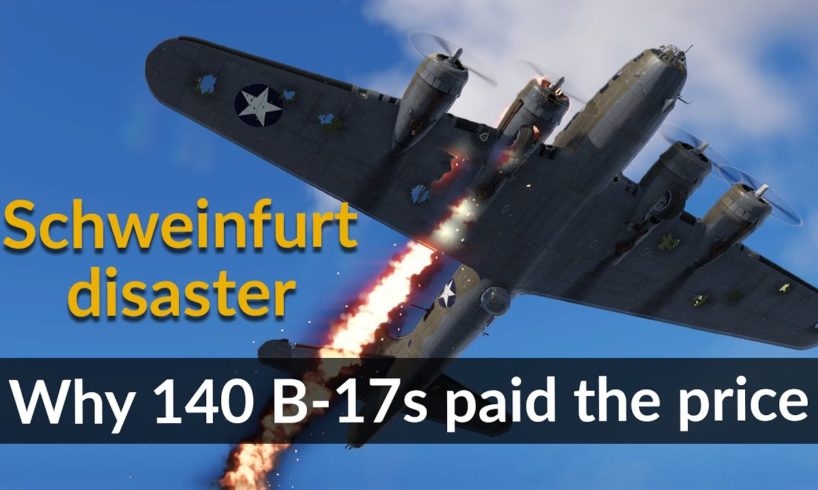
– 25% OFF –
Use code MILAVHIS to receive 25% OFF: https://www.usni.org/press/books
My reading list: https://www.usni.org/press/books?f%5B0%5D=subject%3A1959
The Schweinfurt (and Regensburg) raid was a debacle in many ways but it was also inevitable. Since the 1920s, the USAAC/AAF launched itself upon a trajectory that made a mission like this one a given. Let’s talk about doctrine, assumptions, and path-dependency.
– Check out my books –
Ju 87 Stuka – http://stukabook.com
STG-44 Assault Platoon – http://sturmzug.com
German Panzer Company 1941 – http://www.hdv470-7.com/
Achtung Panzer? Zur Panzerwaffe der Wehrmacht – http://panzerkonferenz.de/
– Support –
Patreon: https://www.patreon.com/join/MilAvHistory
Channel Memberships: https://www.youtube.com/channel/UCmpahmxWXajV0-tuMMzSzAg/join
PayPal: https://www.paypal.me/MilAvHis
– Social Media –
Twitter: https://twitter.com/MilAvHistory
Instagram: https://www.instagram.com/milaviationhistory/
– Sources –
Biddle, Tami Davis; Rhetoric and Reality in Air Warfare: The Evolution of British and American Ideas about Strategic Bombing 1914-1945, Princeton University Press, Princeton: 2002.
Morris, Craig; The Origins of American Strategic Bombing Theory, Naval Institute Press, Annapolis: 2017.
O’Mara, Raymond; Rise of the War Machines: The Birth of Precision Bombing in World War II, Naval Institute Press, Annapolis: 2022.
USAAF, The Official Guide to the Army Air Forces, Bonanza Books, New York, 1988 (Reprint).
Vlaun, Brian; Selling Schweinfurt: Targeting, Assessment, and Marketing in the Air Campaign against Germany, Naval Institute Press, Annapolis: 2020.
Vlaun, Brian; Selling Schweinfurt: Targeting, Assessment, and Marketing in the Air Campaign against Germany, Maxwell AFB: 2017.
Wildenberg, Thomas; Billy Mitchell’s War with the Navy – The Interwar Rivalry Over Air Power, Naval Institute Press, Annapolis: 2013.
– Timecodes –
00:00 – Disclaimer
00:10 – Why Schweinfurt? Again.
01:13 – The Rise of Strategic Bombing
05:59 – Schweinfurt: The Natural Conclusion
09:06 – Recommendations
11:08 – Reactions to Schweinfurt
15:45 – Get 25% OFF
– Audio –
Music and Sfx from Epidemic Sound
source







Happy Thanksgiving y'all
Excellent video. This is the first time I've come across this channel, but I've always admired the Naval Institute. Air power and the bombing campaign in the ETO have always been an interst of mine, since my father joined the Air Corps in 1939 and I was USAFE at Mildenhall in the early '70's.
Schweinehund was a common phrase in war movies
My father flew in the 452nd Bombardment Group, Eighth Air Force. He indicated to me in the 80's that the entire organization was built on pre-existing beliefs. They were told that all those guns would make the bomber immune to fighters, this was categorically false, and proved so from the beginning. They were told the Norton bombsight was the greatest, super accurate one on the planet. It was okay at certain altitudes and conditions, but mostly the bombardier's compensated for it. They were told it would break the will of the German people to resist, despite the Luftwaffe failing to do so to England. On and on and on.
My father was proud of his military service and continued on with the infant USAF for many years after. However, he stated on several occasions that the US Military was the most f***ed up organization he had ever been a part of. As time went on more and more of the lies were exposed and he found it harder and harder to see it in a favorable light.
Thank you for this fresh perspective. I think between the USA and UK we had some "mad bomber" types at the top of the pyramid who thought they would "win the war." They could not back down from that position.
It wasn't the B-17 bombers that "paid the price," as your thumbnail noted. It was the crew of each of those bombers (about 10 airmen on each B-17) that went down. U.S. industry was turning out B-17's like cars, but those aircrews were precious and their losses terrible.
Lots of repetition of the point that "theoretical doctrine" was driving decisions about strategic bombing. Yes, the losses at Schweinfurt were appalling. But to complete your argument, you needed to give us bomb damage data and data about time to recovery to full production. Was the raid a failure because of the high cost in aircraft and human lives or was it a failure because the objective wasn't achieved.
The assumption of this piece is that because strategic bombing advocates in the 20s and "firties" couldn't adjust to facts during the war (I guess that strategic bombing didn't work at all?) that they were only self-promoters who were more interested in keeping their jobs than in actually winning the war. Yes, strategic bombing was not a knockout blow. Herman Goering became persona non grata to Hitler because of his overblown promises and failure to deliver. Bombing on either side didn't win the war all by itself.
I personally think the war would have gone on much longer without it and more lives would have been lost by ground forces than were lost in the air.
Dear sir all videos you make are very interesting! I love military history but I read a lot and I watched a lot , I would like you to start some "modern" history videos such us : the history of the drones ( i think started in Vietnam war), the new air attacks for example: French made Rafals attacking a Lybian air base protected by "modern" antiair systems, air raids in Syrian civil war-results conclusions, now in the war in Ukraine ! History of loitering ammunition plus lessons learned! Attacks of Israel in Beckka Valley i think with drones in the beginning! Air war in Afghanistan why it failed use also of "small" air planes! Air war in Yemen plus the attacks in oil refineries in Saudi Arabia! Technology is advancing so quickly nowadays especially in the air war affair! Thank you!
Great video, Chris and one of your best. I have to admit, I found myself agreeing with you very early on because I have always held a hypothesis of my own which fits in with your message here. People tend to think of aircraft in isolation. I've done it too. Even fighter aircraft are thought of in terms of which one was notionally 'better' because of one technical detail or another. A lot of people who regard themselves as being interested in military history are really more interested in the history of military equipment. That's okay – as far as it goes.
But to understand it is necessary to look more closely. The commitment to the design of the B-17 – what its requirements were, as defined by the envisioned mission – had its genesis in Billy Mitchell's theories about strategic bombing. That meant designing and building that aircraft, expanding on the strategy through operational procedures, training the crew to fly it and another crew to service it and then putting it into service. When the USAAF entered the European war in 1942, this theory had still to be tested properly in offensive operations. The focus of the squadrons was operating the B-17 with all the skills they had been taught and all the supplies they had.
Changing course at this point was going to be extremely difficult – like doing a U-turn in a supertanker. In the Solent. In the dark.
The Americans believed wholly in the value of daylight precision bombing. The fact that the theory and the practice were quite different made for a period of intense head scratching. Daylight precision bombing was an article of faith and that was how the USAAF was configured. It became a self-sustaining system. As we now know, the Americans basically made the same mistake as the British in underestimating Germany's ability to defend herself. While the British changed direction and turned – unsuccessfully – to night bombing early on, the Americans were determined to push ahead because that's how their force was designed to operate. This wasn't arrogance. It was a practical reality.
This early example of over-commitment to one strategy was only really resolved with the arrival of the Mustang. The Americans couldn't change course, so they needed a good fighter escort to help them. Once this happened, they started to achieve a lot more of their aims.
The only other decent video on this is on 'The Operations Room'. That video focuses solely on the mechanics of the raids from the start to the finish. It's an excellent video, as far as it goes but this fills in all the gaps. Well done.
Interesting video. Made me look up path dependency. I can see similarities between the thinking that created the strategic bombing campaign in WW2 and what's happening in and around Ukraine.
I'm wondering though, assuming that one is aware that their strategy / mental framework / etc. may be flawed, to what extent can they try something different? As you mentioned, historians still debate the effectiveness of the strategic bombing campaign. So one could always say: let's keep doing what we're doing, maybe it's effective. Or: maybe it's not as destructive as we hope, but it means the enemy has to divert resources they could have used elsewhere, so it may still be worth doing.
If you had complete control over Allied strategy, what would you have done differently?
The B17g was designed to fly high above the flak, higher than the UK bombers. How did they ever convince anyone that they could accurately bomb anything from those altitudes? That is even before thinking the bombers could adequately defend themselves against fighters.
I think the serious lack for escort fighters proved to be a nightmare for the bomber groups. Imperfect as it was at the time, if there were P-38's available for escort duty in 1943 the bomber losses (in my opinion!) wouldn't have been so ridiculous, especially since the P-38's could have made life difficult for the Bf-110 and Ju-88 heavy interceptors that constantly attacked the USAAF bomber groups during the Schweinfurt raid.
Of course the ammunition load carried was limited and the fighters can see when a bomber has stopped firing their defensive guns. Also the bombers had to defend themselves both ways. Anytime an aircrew had their oxygen system disabled the commander had to descend to at least 12,000 feet asap and that made them particularly vulnerable. An aircraft is a thin shell of aluminum that offers very little protection from the enemy and the elements. It was an incredible effort put forth by all involved on all sides. By the way the flow of ball bearings from Sweden during this period was not hindered at all.
I love the last 30 sec well done Chris! I gotta a book at a great price thx
Did US government fully fund development of the Norton bomb sight?
My father flew on the Schweinfurt Mission & he made a comment that no one else ever made: The B17 & B24 bombers were equipped with .50 Cal machine guns – lots of them. However, the German fighters were equipped with .20mm & .30mm Cannon & rockets. That was a huge advantage because the cannons that the Germans had shot at the bombers outside of the range of the .50 cal machine guns. The Germans could hit the bombers, but the bombers couldn't even reach the German fighters with their weapons. Also, the rockets were unguided but accurate. Their effect was devastating.
According to my dad, the USA took more than 50% casualties. So, 500 bombers go up, but only 200 come back. Worse, all the bombers are shot up by the accurate German 88mm Flack. Here's how bad he said it was: the air-force would sneak replacement aircrews in during the middle of the night as well as airplanes. The survivors would go to sleep with more than half the bunks around them empty but wake up with all the bunks full. More graphically, the only way to get many dead crew members out of their aircraft was to use a firehouse. Think about that.
Finally, just to blow out your mind totally. My father had multiple roles in the Army Air Force. In addition to his duties as head of bombsight maintenance, he doubled as a combat photographer. He took photos of that Schweinfurt Raid and intended to use them in a book or a report of some kind. They were so awful that they were confiscated. He did manage to save a few. He showed me one where a German rocket had made direct impact with the bombardier compartment (nose) of a B-24 Liberator. The bombardier, his bomb sight, his two machine guns, his seat, the glass canopy, and the deck he occupied were all gone. The pilots, although wounded, managed to fly that airplane home in the open air. My dad had that photo. I saw it. I'm a pilot & I have no idea how they got back to their base alive.
It would be nice to see a second video that takes into account the immediate concerns and pressures weighing Eaker/Arnold. Can't be a complete picture of the Schweinfurt "why" without that.
I think this may be the ONLY sponsor advert that I rewound to watch again! Danke!
"milavhis" sounds like a lithuanian coastal defense ship
Anything on JU 88?
Disaster???? When bombers fail to annihilate thousands of noncombatants (a.k.a. "civilians") it is often called an "act of God".
Im from the area of Schweinfurt.
Very interessting video!
I dont know exactly if its true but there were a anti air battery south of Schweinfurt in the fields to protect the ball bearing industry.
Additionally to this the Germans tried to block the sight of the bombers with heavy smoke over Schweinfurt and ignited a lot of candles in the open field to try to confuse the allied bombers.
Unluckily this worked good for some bombers, some missed the field too and heavily bombed nearby villages.
97% of the civilian buildings in Grafenrheinfeld were destroyed.
The village is only around 5 km south from Schweinfurt but the Flak batteries and the candle field were in between.
My dad was a bombardier in the Mighty 8th in a B-17 and fought in the Schweinfurt raid. The great diversion: Daytime bombing pulled Luftwaffe planes and resources off the Russian front. That prevented German air reconnaissance resources from doing their job on things like watching the troop and equipment massing right before the surprise attack on Stalingrad (and that was the turning point in WWII.) The Germans had to respond to daylight bombing because it ruined the moral of the troops and citizens and eliminated the propaganda that said the Nazi's were winning the war. It also prevented the Germans from using close air-support that was critical to the Keil und Kessel or "Blitzkrieg" tactics that were used against allied countries with great affect. Psychologically, the German pilots would rather have to bail out over their home country rather than Russia. The air doctrine that was all theory before WWII came true at Hiroshima and Nagasaki. It was ultimately decisive.
The losses endured during the daylight campaign over Germany were substantial. Curtis Le May tried the bomb them into the ground approach in Vietnam 20 years later. After years of studying air campaigns, I don’t believe air power on its own is enough to win a war. You still need boots on the ground. They dropped more bombs on North Vietnam than ever were dropped on Germany. It wasn’t decisive.
Why didnt the germans move factories further east like the soviets? Was it just a case of having to use the factories already set up and not wanting to stop production, especially with the delay in a war economy being instituted?
My grandmother was adjutant to an anti-aircraft officer in Schweinfurt and there is a museum here where you can see all the anti-aircraft batteries that were in and around Schweinfurt
Grüße aus Schweinfurt 🙂
Maybe my thinking is a little simplistic, but if Hitler had made a peace treaty with France and other Atlantic nations. And withdrawn his forces from there. Then Britain and the R.A.F wouldn't be in a position to attack Germany. Not to mention the freeing up of all that man power and equipment then holding down those territory's.
You're getting better and better! That little trick at the beginning where you answer your video-screen-self is very effective. As was the same scenario in the sponsorship portion. Really well done!
Schweinfurt B-17 disaster < Erfurt latrine disaster (look it up)
To isolate ball bearings as a critical German bottleneck and attack their source was a brilliant idea, but without fighter support I don't know how any of the planes got there and back. Long range fighters came just a little too late for these brave men.
I wish you started with explaining what schweinfurt is even about
or at very least added it into description
I feel like extending this examination to Korea, Vietnam and then onto the gulf wars would be very interesting.
Schweinfurt was a meaningful target, which is why they took the risk to strike it, instead of taking lower losses on less meaningful targets, because they were to make a difference. Yes, it was too costly becuse the battle plan went awry, but not every battle is won. You take losses even when you win a battle, and when you become averse to losses you sue for peace. The USAAF was at war, and not about to give up at the first setback. It actually took the second costly attack on this target to cause them to take a pause in deep operations and wait for the fighters that were in the pipeline.
Our thinking in 2022 seems to be conditioned by the almost antiseptic utility of allied airpower in the last few decades, and we forget that it was a bloody and uncertain business back then, just like most other ways of making war.